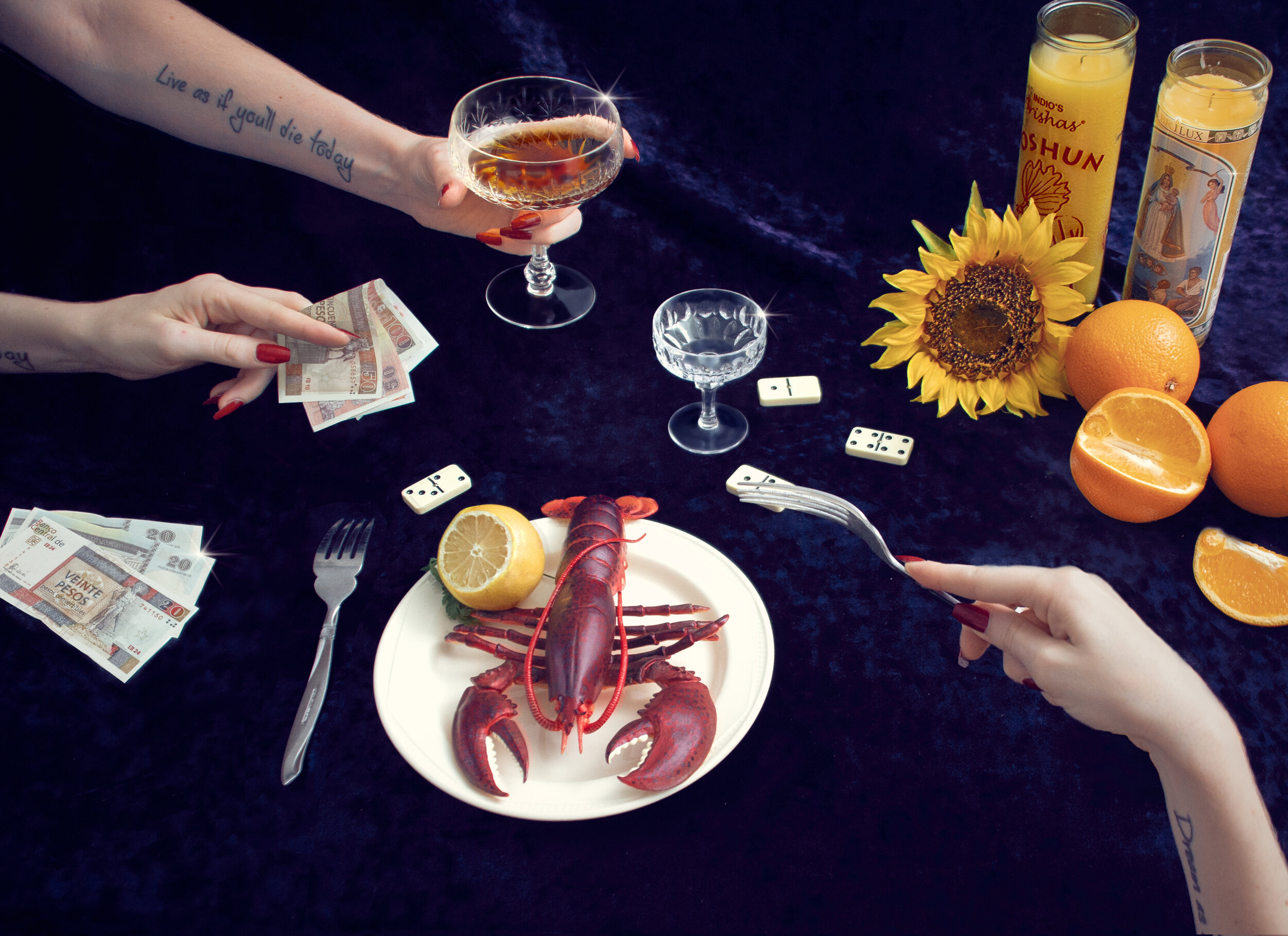Lobster and potato bread
I am sitting here in this gentlelady’s home-turned-restaurant licking the juice off my hands. The carcass lays on my plate. I am lobster-craving satiated.
Dark rum has just been poured into my glass, and a box of cigars lands on my table. “On the house,” the owner’s son says. How sweet!
I take a puff, a sip, and a puff again. It’s winter back home, but here the sun keeps shining, the classic cars purring, and I am treated like a Very Important Person.
Usually, I’m low-key, but shit, I’m on holiday.
Stretched-out legs. Cry of satisfaction.
And I can hear the warm breeze from a fan caressing my skin.
Tony walks by, looks inside, and waves at me.
I drop a few CUCs on the table, shout a hurried “Thank you!”, and join him for a stroll with no destination in mind.
We stop at his work, a bookshop on Obispo Road. He picks up a Hemingway, puts down a few oranges next to Oshun, and here we go again shuffling across the dusty roads of Habana Vieja like two capricious souls.
Careless. Free.
More restaurants and bars full of Americans eager to make up for lost time. Some Italians and French. Some Germans too.
“These are Paladars,” Tony says. “A mecca for people like you.”
“And for you?” I ask.
“Well, it’s potato bread and state restaurants.”
In 1993, Fidel reluctantly introduced the US dollar. The idea was preposterous. History has shown how much he despised the USA–he could see right through that boujee bitch–but it was his only chance to save Cuba’s fragile economy and end the Special Period. Tourism was back. The CUC, Cuba’s only hard currency, was created a year later, worth 25 times as much as the local money, the CUP. Fidel’s brother Raúl allowed private enterprises. Small businesses sprang out. Parts of houses were used as restaurants where cotton tablecloths and unmatched cutlery became the Havanese charm. It was a mini revolution, the very one that acted as a catalyst for change.
Capitalism has made an entrance into the land of Communism.
Consumption and competition tiptoeing into the Cuban Revolution and its egalitarian society. Fancy rums in shop windows, generous meals served with a smile, a portrait of Che on sale–the irony.
It’s shiny, prosperous, and whispers tales of a better life.
A better life most Cubans can only watch from afar.
See, the tourist industry is now fueled with hard currency.
The rest of the economy is controlled by the State, a relic of the Cold War.
So obtaining CUCs for Cubans can be extremely difficult.
Tony was an English teacher who talked a lot with a mischievous gap-toothed smile. He earned the equivalent of £20 a month. Working for the government’s ass, how is he gonna live a decent life?
He only held CUPs, and he was tired of ration books.
He quit and became an antique bookseller.
Free Hemingway stories for any inquisitive travelers spotted in line.
He was like many journalists, chemical engineers, and doctors who became taxi drivers, art sellers, and Paladar owners so they could get closer to the good stuff. And yet.
Tony takes a drag from his cigarillo. His belly is screaming.
He drags me to this place in San Rafael where joyful voices are flying like bees on edge. Scratching knives and forks, clinking glasses.
The Che framed against the cracked anise wall is overlooking the crowd, protecting his hunched revolutionaries chewing on beans.
Tony orders some pollo y arroz.
The waitress flings a basket of potato bread on the table.
“I’ll have a Cuba Libre, please.”
“5 CUPs, chica.”
I reach into my pocket and pull out a 5 CUC bill.
“Sorry, miss. I only have this.”
She smiles. It’s her lucky day.
Aurelie Guichard explores service via the study of countries she has visited and her identity as a tourist. Cuba was an interesting choice for the artist due to the duality of the Cuban economy. The two-currency system, created in 1994 to deal with a fragile economy, has separated the country into two different worlds. One of the most obvious examples of this is the dissociation is hospitality—tourists have access to paladars (independent restaurants housed in people’s home), lobsters and CUCs, while locals eat basic dishes (due to the ration books and lack of food) in state restaurants and pay in CUPs (= 1/25 CUP).
This series addresses hedonism and other external pleasures a tourist seeks, sometimes at the expense of the local population. It examines the constant duality of comfort versus hustle, shiny versus raw, consumption versus constraint, and hedonism versus eudaimonia. A duality that is expressed in the choice of both still life and street photography.
French-born and London-based, Aurelie taught herself how to take pictures during a 2015 trip to Thailand. Experimenting with the camera made her understand the power of storytelling: why a country looks the way it does, who are its people, what are their stories… Writing came soon after. Aurelie’s work showcases unique narratives and captures a moment, an emotion. Aurelie created Small Eyes Big City, an online publication that delves into culture and politics through traveling, in an attempt to share stories and understand the many layers of life. Some of Aurelie’s projects have been exhibited at Numbi Art festivals. Aurelie’s “The Revolution of the thread and needle,” a series of Mardis Gras Indians portraits, was showcased at Black South, exploring the legacy of the Afro-American southern culture to open a discussion on forced mass movements and identity construction.





